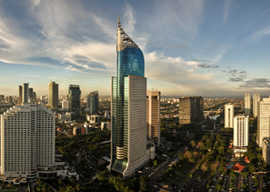
September 20, 2012

Jakarta, Indonesia
It’s this building bottleneck that concerns the 20 percent or so of US companies who have expressed interest in shifting their business from China but cite Indonesia’s “inadequate infrastructure” as a deterrent. Indonesia has investment-grade ratings without investment-grade roads.
Indonesia’s challenges will not be overcome overnight, and the country’s trajectory remains uncertain. Still, there are a number of promising initiatives that will help Indonesia take its place among the world’s fully developed democracies.
First, the Indonesian government must follow through on its recently proposed education master plan, which would sharply reduce secondary-school dropout rates, boost the number of scholarship recipients, and produce 4,000 new Ph.D.s annually.
Second, the US and Indonesia should continue their close collaboration in education, building on George W. Bush’s $150 million or so in aid to bolster learning quality and combat extremism. USAID’s Decentralized Basic Education Program has improved teaching and management for almost half a million students in nearly 1,500 schools across the country, while the Obama Administration has committed $165 million to support educational exchanges through a Higher Education Partnership, in addition to strengthening science and technology ties. A Sesame Street adaptation, Jalan Sesama“which translates to “street for all””has improved literacy, numeracy, and diversity for 7.5 million young Indonesians.
Third, Indonesia must actually commit to building “streets for all,” beginning with implementing President Yudhoyono’s plan to streamline regulations and increase infrastructure spending by 15 percent next year. Foreign investment will be key, with one American economic attaché informing me that “the opportunities for the US in infrastructure are enormous, but we have no coordination.” As the third-largest investor in Indonesia, the US has already invested nearly $703 million in the first half of 2012, and a recent agreement for American firms to invest $5 billion in manufacturing, transportation, and energy infrastructure over the next two years would go a long way. Coupled with recent World Bank loan guarantees and a new land-acquisition law to facilitate such projects, there are encouraging signs that Indonesia is finally serious about wooing foreign investors.
Five years ago, a young Indonesian entrepreneur told me, “We need to invest in infrastructure and education”but where is the leadership?” As Indonesia faces a crossroads, perhaps it will be one of the passionate young Mengajar teachers, someone who has seen Indonesia’s diversity and difficulties, who will show the country how to build the roads to its bright future.
Image of Jakarta courtesy of Shutterstock